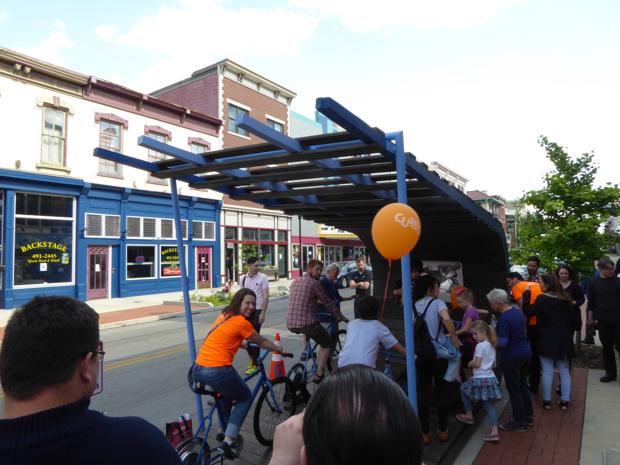In front of the Left Bank Coffeehouse in Covington, Kentucky, a giant wooden igloo-like structure sits flush against the sidewalk. It takes up an entire parking space. From its beams, passerby hang their personal, handwritten wishes out to flutter in the breeze.
The Wish-Igloo is one of five parklets to pop up in Covington this past spring. Installed on May 6, they’ll be around through the end of October. Through a program called Curb’d, local businesses and design teams paired up to pitch ideas for the installations last fall. Out of a pool of 11 finalists, five were chosen, says Sam O’Connor, the founder and program manager of Curb’d.
O’Connor was working for People’s Liberty, a philanthropic community organization based across the river from Covington in Cincinnati, when she latched on to how parkets can transform places. While managing People’s Liberty’s basement gallery, O’Connor began to wonder how they could draw the lunch crowd from the popular market across the street to the exhibit space. O’Connor and the People’s Liberty team installed a life-size version of Cards Against Humanity in a parking space in front of their organization, asking people to hang fill-in-the-blank responses to the prompt, “Cincinnati Needs…” from a piece of black plywood.

But to expand her idea that would grow to be Curb’d, O’Connor looked across the Ohio river, to Kentucky, where they landed on Covington. “We wanted to find a neighborhood that would be as excited about the project as we were,” O’Connor says. Renaissance Covington, a local nonprofit, has been working to revitalize the city’s downtown area, focusing on promoting independent businesses unique to the Kentucky city; when O’Connor pitched the organization her idea, “they were immediately hooked,” she says.
For each of the five selected businesses, the parklets offer a whimsical interactive experience where a car would otherwise sit. The Braxton Brewing Company is now home to Hopscotch Gardens, where adults can sit with a beer while kids clamber through tiers of nooks and crannies and jump around on the sidewalk; they can also walk into Stoney’s Village Toy Shop, grab a mallet, and bang on the larger-than-life xylophone parklet there. At the Cutman Barbershop, the mini installation appeals to the storefront’s old-timey vibe with a boxing-ring theme, complete with Rock ‘Em Sock ‘Em Robots; the restaurant Inspirado takes dinner-and-a-movie to the next level with its parklet, Ride, named for its outdoor movie theater powered by stationary bikes.

The parklets span downtown and MainStrasse, connecting the two areas. “It’s about creating destinations,” O’Connor says. If people plan to see the parklets, they’ll often seek out all of them; if they happen to come across just one, they’ll get interested in walking across town to see the rest. They’re designed as activities in and of themselves; unlike parklets in San Francisco or Chicago, O’Connor says, which are mostly aimed at providing more seating, Covington’s installations are focused on interaction.
It’s a model she thinks could work well everywhere. O’Connor has her sights on reaching other parts of the Cincinnati area. Funding is an issue (the Covington parklets were each awarded a $15,000 grant from the Haile Foundation, which also funds People’s Liberty), but the benefits of these mini parks, O’Connor hopes, will pay dividends.
“They’re just these great ideas,” she says. “They promote walkability, but also bring some character into the neighborhood.”















